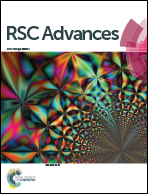Redox transformation reaction for hierarchical hollow Au–MnOOH flowers for high SERS activity†
Abstract
Hierarchical metal–semiconductor hybrid (Au–MnOOH) nanocomposite flowers with a hollow spherical base and prickly tipped divergent petals have been obtained for the first time by facile one step redox reaction. The wet chemical method reports a direct growth of Au–MnOOH nanocomposites through a redox reaction between Mn(II)-acetate and HAuCl4 in aqueous solution. A thermodynamically controlled synthetic strategy requires no foreign reducing agents, stabilizing agents or pre-treatment of the precursors, making the strategy a practical method for obtaining metal–semiconductor hybrid nanomaterials. Liberated HCl (related to HAuCl4 concentration) from the underlying redox reaction selectively etches out MnOOH from the spherical composite flower base i.e., the nucleation zone. Thus the flower base becomes a hollow basket with the roughened Au nanoparticles (NPs) surface bearing “hot spots” within. Finally the hollow nanocomposite Au–MnOOH flowers with prickly tipped divergent petals increase SERS activity with thiophenol (TP) and 4-aminothiophenol (4-ATP) as probe molecules. We observe the effect of the metal–semiconductor hybrid nanomaterial for giant SERS signal enhancement in comparison to the individual components. The Au–MnOOH nanoflowers with 5 atomic% Au show the best SERS enhancement with the probe molecules down to the single molecular level (EF > 1015) due to charge transfer (CT) as well as electromagnetic (EM) effects. Hierarchical hollow Au–MnOOH nanoflowers become a stable deliverable for extremely sensitive and reproducible SERS studies.


 Please wait while we load your content...
Please wait while we load your content...